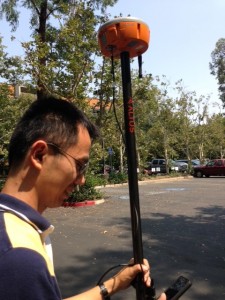 Implementing mobile solutions that target the needs of your field workforce, that leverage your investment in the ArcGIS platform, and are available on the most modern and cost effective device platforms is critical when defining your mobile strategy.
Implementing mobile solutions that target the needs of your field workforce, that leverage your investment in the ArcGIS platform, and are available on the most modern and cost effective device platforms is critical when defining your mobile strategy.
Location is important and depending upon what you are mapping, locational accuracy can make or break a GIS. When considering the use of smartphone and tablet platforms one of the first questions you may ask is – how accurate is the GPS?? The answer to this question will shape the decision you make on device platforms. Or will it??
Cellular-enabled smartphones and tablets include an integrated GPS chip-set manufactured by companies like Qualcomm, Broadcom, CSR and others. These chip-sets are designed first for power consumption, second for time to fix and third for locational accuracy. What we found in our testing is that locational accuracy is pretty much the same regardless of manufacturer. In the open sky, mapping with several devices approximately 90% of all positions collected fell within 3m of our baseline. These results were not too shabby really!  In canopy conditions where we encountered significant multi-path interference from the receiver, results were considerably worse.
In canopy conditions where we encountered significant multi-path interference from the receiver, results were considerably worse.
Most of the chip-sets support GNSS (Global Navigation Satellite System) which means they support both the United States NAVSTAR GPS satellites and the Russian GLONASS satellites. That means you have a better constellation of satellites to draw from when you are in the field.
Next we connected our smartphones to external GPS receivers that were considered “consumer grade”. These chip-sets are designed first for locational accuracy, second for time to fix, and third for power consumption. Here we found that you can purchase a variety of receivers that connect either directly to the device or via Bluetooth and most with SBAS capabilities! In the open sky, virtually all positions captured (99%) were within 3m and almost 70% were within 1m of our baseline! As expected, positions degraded in canopy conditions but overall were much better!
Finally we connected an iPhone 4s to a high-accuracy, dual-frequency, survey-grade receiver from Altus Positioning Systems using a commercial product called GPS Cable from Aman Enterprises Inc. The GPS Cable will create an external connection to virtually any external GPS receiver using RS-232 and stream NMEA to the location manager on your smartphone. This replaces the location source in the same fashion as the external “consumer grade” GPS device does. Not to embarrass the other receivers we tested, and to ensure that we were only using the receiver itself and not supplementing our source using NTRIP (which we could have done), we chose to only map using SBAS and not fully leverage the true capabilities of the receiver. Even so we found that virtually all positions (over 92%) were within 1m!! 
A couple of additional points worth mentioning – PPP (Precise Point Positioning) is becoming a reality and with it you can achieve centimeter level positioning directly from a satellite lock! This is a great solution for mapping efforts that require high accuracy, do not want to post-process positions, and do not have access to RTK networks.
So before you consider spending a fortune on mobile devices from hardware vendors that promise sub-meter accuracy with a complicated field to office workflow, consider your field needs and the possibilities of using a smartphone instead! Couple your hardware decisions with the Collector for ArcGIS app and implement a great low cost field data collection solution for your field staff that have not been trained in the underpinnings of high accuracy GPS positioning and want to collect data on a modern device!
To look at some of our tests, check out this web map. Let us know what you think and what you would like to see regarding device testing from Esri.
Mobile Team

Article Discussion: